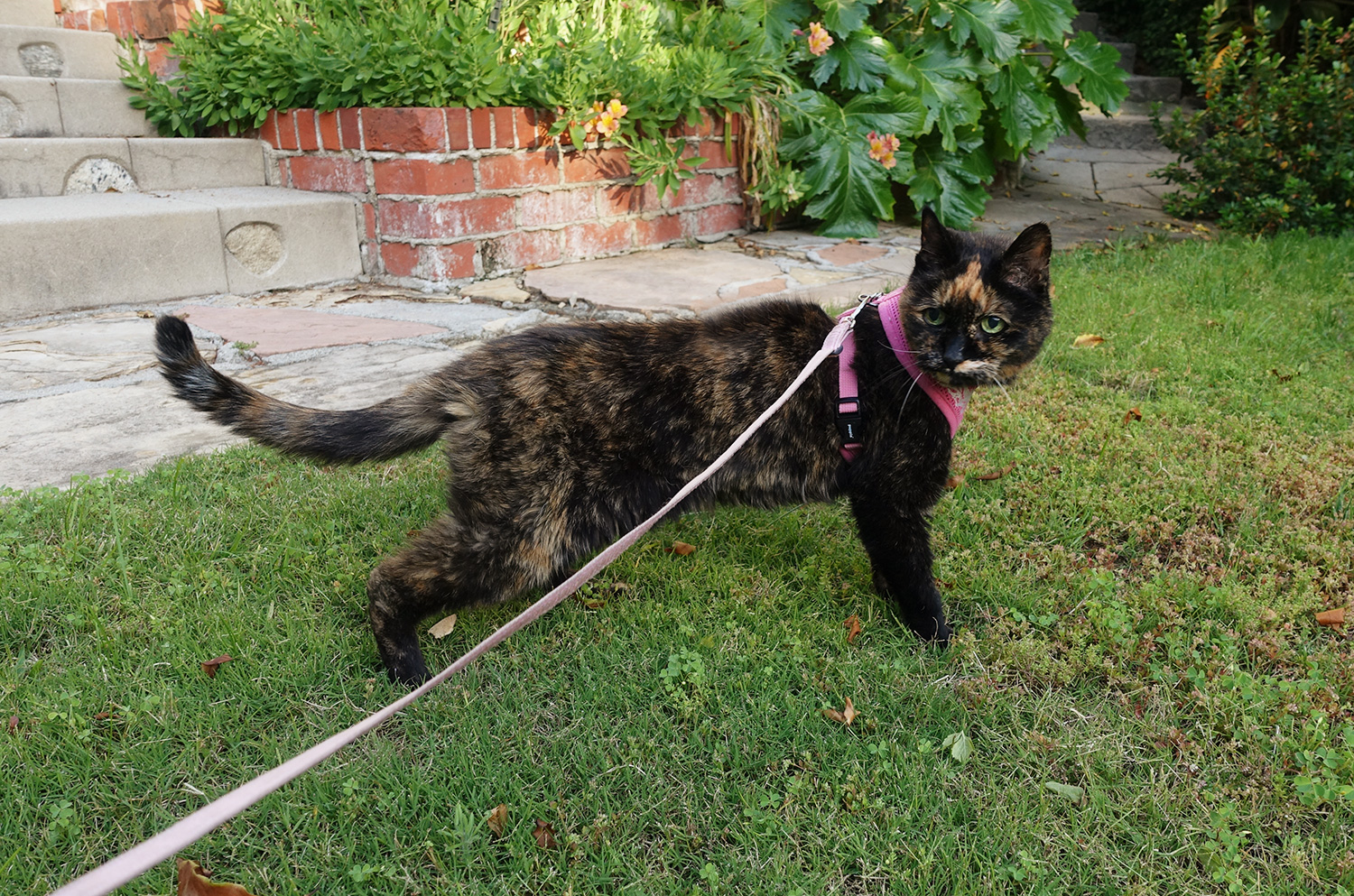Koshka Hellqvist wanted a nice time at Boston’s Binford Park with her two Abyssinian cats, Jake and Angel. Jake, a certified therapy cat, was experienced at walking on his leash. Angel was shyer, but still willing to explore. But several dogs were running around free, against Boston’s leash laws. Without warning, a Rottweiler mix appeared by the cats’ stroller. Instantly, Hellqvist grabbed the dog’s collar, and yelled for the owner. The owner hooked up the dog’s leash, but not before she and Hellqvist had a few words. Fortunately, no one was injured, but it was enough to rattle any responsible cat parent.
While taking a cat out on walks, either around the neighborhood or on hikes, can be a great form of enrichment, it’s not without dangers: off-leash dogs, loud noises that might cause a startled cat to bolt out of her harness, the possibility of injury. Is it possible to keep your cat safe when you are out together?
The truth is, accidents can happen anywhere, even inside your home. Whether you are just outside your front door or trekking through nature, it’s important to take precautions to keep your cat safe. If you are properly prepared, it lessens the risks significantly and makes your outings nearly worry-free.
Risk Aversion
Annie King, a Fear Free certified veterinarian who often goes on outings with her cat Emmylou, says a good harness that fits well is the number-one priority. A cat startled by an approaching dog or a loud noise such as a car backfiring can squirm out of an ill-fitting harness in the blink of an eye and be extremely difficult to catch. A snug-fitting harness is a necessity. Test how secure the harness is long before you ever leave the house.
Always take a safe space. Bringing a carrier on outings can be unwieldy, so many people who go out with their cats have backpacks that are made especially for pets. Connie Lipton, who frequently takes her cat Max on trails or to local parks, says she and her husband always take his backpack with us so he can go inside quickly or we can put him in quickly if there’s danger. Alpine, who belongs to Amida Kuah, understands that the backpack is his safe space. “If we meet a big dog or he gets scared he will jump back into the backpack himself,” she says.
Some people prefer a stroller for city or urban treks. That was the answer for Hellqvist while she lived in Boston, and Jacoby was even nicknamed “Stroller Cat” and gained a bit of local fame. Another idea for short walks and lighter weight cats is a pet sling, which is convenient for taking your cat shopping at pet-friendly stores. No matter what you choose, always keep your cat in her harness and leashed up.
Always be aware of your surroundings. “When hiking with Emmy, I am constantly scanning our environment, on the lookout for off-leash dogs or other dangers,” Dr. King says. When you are out with your cat, you are functioning as her bodyguard, and her safety should always come first.
You may also want to educate yourself on which plants you encounter are either toxic to or safe for cats, so you can keep away from dangerous ones. The ASPCA has a helpful resource here.
Cat Senses
Pay attention to your cat. “They have better senses than we do,” Dr. King says. “Emmylou often hears or senses possible dangers well before me. If she hunkers down or moves to hide in the bushes, I start looking for the reason. Sometimes it’s just other hikers, but often it’s a dog or other concern that needs to be monitored.”
Dogs will probably be your main concern. “Off-leash dogs have been our biggest safety challenge on trails in our area,” says Dr. King. “We carry a can of citronella spray to use as a deterrent in an emergency. It’s safe for the dog but should discourage them from harassing us. Luckily, I haven’t had to use it since I bought it!”
Many, but not all cats, are wary of strange dogs. Max is one of them. “When we are in the neighborhood park he may see a dog in the distance and just want to crouch down and watch what he’s going to do,” says Lipton. “We try to be patient with him and not make him get up to walk until the dog is out of sight and he’s ready.” Even cats who are friendly toward dogs (and vice versa) should never be allowed to interact with them out in the open. It’s a recipe for disaster.
Always carry a first aid kit. This isn’t so crucial on short treks, but the longer your outing is, the more important it is to be prepared. “We had a scare with a yellow jacket near about three miles deep into the woods,” says Dr. King, “so I always carry Benadryl with us when we hike!” In addition to a first aid kit, carry the phone numbers and addresses of the veterinarians nearest your location.
Keeping your cat safe while you are out with her takes some preparation and planning, but the enrichment and bonding potential makes it well worth the effort.
This article was reviewed/edited by board-certified veterinary behaviorist Dr. Kenneth Martin and/or veterinary technician specialist in behavior Debbie Martin, LVT.








